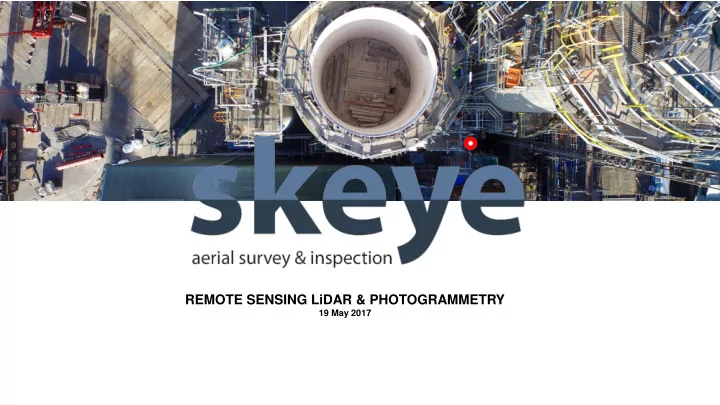

REMOTE SENSING LiDAR & PHOTOGRAMMETRY 19 May 2017
SERVICES Visual Inspections Digital Terrain Models Volume Computations Aerial Imagery Thermal Inspections Photo maps Aerial Video Training & Consultancy
SYSTEMS Zenith (2 x) Asctec Falcon V8 (3x) SkeyeBat MD4-1000 DJI Inspire I (2x) Trimble UX 5 HP HEF-30 (2x) Cessna Balloon (5x) 3
CLIENTS
UAV LiDAR vs PHOTOGRAMMETRY 5
LiDAR PRINCIPLE Transmitter Distance = Time of travel / 2 Speed of light Reflector Receiver 6
BATHYMETRIC LiDAR 7
LiDAR PRINCIPLE ACTIVE LIGHT 8
POSITIONING LIDAR 9
POSITIONING LIDAR 10
POSITIONING LIDAR 11
POSITIONING LIDAR 12
POSITIONING LIDAR POSITION AND ORIENTATION ERRORS ARE NOT THE SAME FOR ALL RETURNS PER SCAN => NOT CORRELATED 13
LiDAR ERROR SOURCES Sensor Position GPS error INS/IMU error GPS-IMU Integration error Angular Errors Misalignment between LiDAR scanner and IMU (Boresight calibration) Lever arm Error Incorrect positioning between GPS antenna and LiDAR sensor LiDAR Range Error Precision of LiDAR scanner Divergence of Laser beam Multipath error Reflection on a sloping surface 14
LiDAR ERROR SOURCES Range Between 5 mm to 20 mm Position With RTK or PPP Positioning between 15 mm and 50 mm Orientation Between 0.025 degrees and 0.15 degrees Example Sum of all errors Velodyne HDL 32E Scanner Flying Height 60 meters AGL (Above Ground Level) Range error: <= 20 mm GNSS Positioning Horizontal: 1 cm + 1ppm, assume 11mm Vertical : 1.5 times horizontal = 16.5 mm √ (11 mm 2 + 16.5 mm 2) = 19.83 mm Total = Range and Positioning error: 20 mm + 19.83 mm = 39.83 mm 0.15 ° ⟹ 60 meters Range = 60 * tan(0.15 ° ) = 15.7 cm IMU accuracy Pitch and roll: 0.025 ° ⟹ 60 meters Range = 60 * tan(0.015 ° ) = 2.62 cm IMU accuracy Pitch and roll: Total Error = √(15.7 2 + 3.9 2 ) = 16.18 cm / Total Error = √(2.62 2 + 3.9 2 ) = 4.7 cm 15
LiDAR PROJECT SCHEVENINGEN BREAKWATER
PHOTOGRAMMETRY 17
PHOTOGRAMMETRY 18
PHOTOGRAMMETRY 19
PHOTOGRAMMETRY POSITION AND ORIENTATION ERRORS ARE THE SAME FOR ALL PIXELS PER PHOTOGRAPH CORRELATED NOT WITH ROLLING SHUTTER !! 20
Rolling Shutter and Photogrammetry 21
STEREO VIEWING 22
PHOTOGRAMMETRY
PHOTOGRAMMETRY
PHOTOGRAMMETRY ALLIGNMENT
PHOTOGRAMMETRY
PHOTOGRAMMETRY
PHOTOGRAMMETRY ACCURACIES General ‘rules of thumb’ for photogrammetry with dense matching techniques - Relative accuracy is influenced by resolution (GSD, Ground Sampling Distance) - Absolute accuracy is influenced by quality of the geodetic network (i.e. ground control points) - Absolute accuracy is influenced by the data processing methodology - If all of the above are favorable: - X,Y accuracy is 1 to 1.5 times the GSD - Z accuracy is 1.5 to 2 times the GSD - Absolute accuracy is the quality of the network + relative accuracy Sample project Scheveningen breakwater - Flight altitude 40 meters with Sony A7r (36 Mp and 35mm lens) => GSD = 0.7 cm - Quality of the Ground control points assumed at 2cm X,Y and 3 cm Z A priori estimated error = √((1.5 ∗ 0.7) 2 + 3 2 ) = 3.18 cm -
PHOTOGRAMMETRY SAMPLE PROJECT
PHOTOGRAMMETRY SAMPLE PROJECT
PHOTOGRAMMETRY SAMPLE PROJECT
PHOTOGRAMMETRY ACCURACIES BREAKWATER SCHEVENINGEN Height X Y Level GPS DEM Dz-1 Dz-2 Absolute Dz-1 Absolute Dz-2 77542.555 457425.012 GCP01 5.676 5.681 5.686 0.005 0.010 0.005 0.010 77519.250 457437.892 GCP02 5.117 5.117 5.118 0.000 0.001 0.000 0.001 77524.464 457471.887 GCP03 4.607 4.623 4.62 0.016 0.013 0.016 0.013 77534.839 457515.828 GCP04 5.557 5.564 5.564 0.007 0.007 0.007 0.007 -0.001 77482.622 457470.247 GCP07 4.542 4.544 4.541 0.002 0.002 0.001 -0.002 77455.233 457499.366 GCP08 4.525 4.533 4.523 0.008 0.008 0.002 -0.003 77326.597 457699.824 GCP14 4.519 4.521 4.516 0.002 0.002 0.003 -0.002 77285.905 457852.778 GCP20 4.511 4.509 4.511 0.000 0.002 0.000 -0.002 77283.584 457876.050 GCP23 4.496 4.502 4.494 0.006 0.006 0.002 Average 0.005 0.003 0.005 0.004 STDEV 0.005 0.006 0.005 0.005 Dz-1 = Difference Level - GPS Dz-2 = Difference Level - DEM
LiDAR vs PHOTOGRAMMETRY (UAV ONLY!) LiDAR Photogrammetry ✔ Vegetation Penetration ✔ Accuracy ✔ Detect smaller features (i.e. power line) ✔ Costs ✔ Quicker data processing ✔ Weight ✔ No (or little) Ground control ✔ Picture ✔ Active light (better in dark/shadow areas) ✖ Only map what you see ✖ No Picture ✖ Longer Processing times ✖ Accuracy ✖ Cannot detect small features ✖ Cost ✖ Ground Control (even with RTK or PPK!) ✖ Weight (i.e. safety) ✖ Less accurate in shadow areas CONCLUSION: One sensor is not ’better’ than the other. Depends very much on the type of project.
Recommend
More recommend